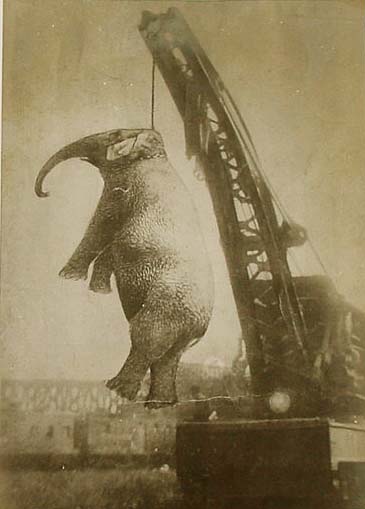Performing elephants were very common in circuses during the 19th and 20th centuries.
Circus owners would often treat these animals with cruelty and subject them to great physical and mental stress.
Poster of the Forepaugh & Sells Brothers circus.

She was known for her foul mood.
Some accounts suggested that she killed two circus workers, previously.
In June 1902, another spectator tried to tickle Topsy behind the ear with a stick.

After this incident, to prevent further harm to their reputation, the circus decided to sell Topsy.
An illustration of Topsy as published by the St. Paul Globe, June 16, 1902.
Photo:Wikimedia
Topsy was acquired by Coney Island’s Sea Lion Park, later renamed Luna Park.

They also hired Topsys handler, William Alt, from Forepaugh, because only William could control Topsys temper.
But William had a loathsome habit of getting himself excessively drunk.
Once while intoxicated, William stabbed Topsy with a pitchfork and let her loose on the streets.

As a result William was fired.
But now with William gone, there was no one to handle Topsy.
The owners of Luna Park tried to give her away but there were no takers.

So it was decided that Topsy would be put to death by electrocution.
But once on the bridge, as if sensing her fate, Topsy refused to budge.
They tried to coax her with carrots and apples, but in vain.
They even tried to get William Alt to lead Topsy across the bridge, but even he refused.
Finally they gave up and decided to execute Tospy where she stood.
As the crowd waited, the execution site was dismantled and reconstructed in the main park grounds.
Topsy refuses to cross the bridge over the lagoon to the execution platform.
Topsy collapsed without a trumpet and groan, and within ten seconds she was dead.
Topsy at the moment of electrocution.
Photo:Wikimedia
The execution of Topsy was extraordinary but hardly exceptional.
Mary was another such unfortunate victim.
She was a five-ton Asian elephant who performed in the Sparks World Famous Shows circus.
On September 11, 1916, the circus hired a drifter named Red Eldridge as an elephant keeper.
The crowd was horrified.
Some of them began chanting Kill the elephant!
Let’s kill it, and a local blacksmith fired at Mary injuring her.
At the first attempt, the chain snapped, causing Mary to fall and break her hip.
She died during the second attempt and was buried beside the tracks.
Some elephant execution played out like big-game hunts with armed citizens chasing the beast through the streets.
A local hardware store even threw open its doors for all to procure rifles and ammunition.
The elephant was eventually murdered on the streets; its body riddled with bullets.
These executions were conducted as much as for thrill as for retribution.
A retributive sense of justice demanded it despite any sympathy and affection the public might hold for the beasts.
But not all executions went as planned.
But the 4,000 volts that surged through his body had little effect.
Jumbo wagged his tail… looked like and trumpeted a bit, wrote theNew York Herald.
Elephant execution became largely obsolete by the 1920s.
The majority of these executions took place in cities between the 1890s and the early 1900s.